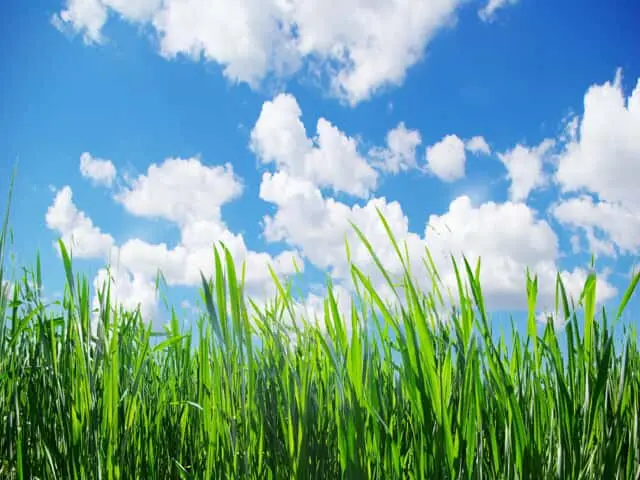Bermuda Grass
Bermuda grass kicks off our list for one distinct quality: it is brilliant at thriving in drought conditions and low-water environments. Extreme temperatures that soar well over 100 degrees? Child’s play. No ran in over four straight months and lakes being well below expected levels? Doesn’t matter. Bermuda grass has root systems that can grow over six feet long to seek out water and moisture. In fact, it gets its nickname “Devil’s Grass” for its ability to persevere and continue to aggressively spread with almost weed-like efficiency.
Because Bermuda grass tends to grow so quickly, recovery from injury or heavy use is pretty simple as well. This makes it a popular choice for golf courses throughout the southern United States. Some architects of golf courses revere it for its ability to grow quickly and completely change how a golf course plays throughout the day. However, this aggressive spread is also an issue—Bermuda is known for getting into flower beds and gardens, overrunning flowers and other plants by consuming resources.
Fescue Grass
Have you ever seen video of long, brilliantly green blades of grass on a hillside, making waves as it blows in the wind? It’s a beautiful sight to behold, and it is perhaps the best example of what fescue grass is capable of when left on its own. Fescue is known for its long, tall, and thin blades that can grow incredibly fast. It is also a great choice for those who want a lawn that is characterized by longer blades (recommended mowing height is anywhere between two and four inches in length).
However, fescue is also the only type of grass on this list that is known as a “cool” grass. It does great in shade, but it tends to suffer in excessive sunlight and extreme heat. For that reason, it actually doesn’t work all that well throughout the overwhelming majority of the state. In fact, the DFW metroplex and areas just to the north, south, and east are pretty much the only areas where this type of grass really grows.
Zoysia Grass
Zoysia grass is probably the second-most common type of grass found across North Texas, second only to Bermuda. It is a warm weather grass that goes dormant during the winter months, but it does great in shady conditions, handles drought conditions with little difficulty, and handles traffic and heavy sustained use with little to no problem. This makes it a great choice for golf courses and athletic fields as well as home lawns or commercial landscaping installations. It also does pretty well in cold weather, meaning it will withstand the frigid cold of North Texas winters often without a scratch.
The biggest downside to zoysia is that it is typically a slower recuperator than other species. Wounds and problems are generally slower to recover with this type of lawn than others, and this means mistakes or faults tend to stand out. Zoysia is also particularly hard on mowers—you’ll need to sharpen your mower blade a lot more often with this type of lawn because the blades are known for being coarser, stiffer, and harder on machinery.
St. Augustine Grass
St. Augustine is a widely popular type of warm season turfgrass used throughout the southern United States. It is known for its signature blue-green color, its thick blades of grass, and its several varieties that allow it to grow easily in a wide variety of different conditions. For example, if your lawn receives a lot of shade, Palmetto St. Augustine might be the best widely-available turfgrass on the market. Certain strains are also renowned for their durability, their hardiness, and their ability to recover from injury, making them an ideal choice for golf courses and outdoor sports like soccer or baseball fields.
St. Augustine comes in a number of varieties, but varieties add complexity. The wrong type of St. Augustine could lead to frustration, as your lawn may die out or refuse to grow if conditions are not right. Likewise, St. Augustine is a pretty thirsty type of grass. However, with regular watering from an optimal irrigation system, this type of grass makes a flourishing home lawn.
Centipede Grass
Centipede grass might be the most unique and atypical type of grass on this list because it is quite a bit different from virtually any other type of grass out there. Centipede grass gets its name from the fact that its blades look like little centipedes crawling along the ground. No, that doesn’t mean it has tons of tiny little legs that sprout from each blade, but it does mean that the blades themselves grow sideways. Yes, centipede grass is a type of grass that naturally grows flat.
This type of growth pattern has huge advantages when it comes to maintenance. Centipede grass needs to be cut far less often than other types of grass, and it continues to look great even when it hasn’t been cut for quite a while. It also needs less feeding and treatment than other types of grass, although you probably will need some pretty sharp mower blades to make sure you’re properly trimming it. However, this comes with a trade-off: Centipede grass requires a lot of water. In fact, it isn’t recommended for anywhere that receives less than 40 inches of annual rainfall. While it is renowned for being drought tolerant, it also doesn’t do well in areas that receive a decent amount of shade. Homes with one or two large trees on their property might want to consider a type of grass that does fairly well in shady conditions over this type of turf.
For all of your lawn care needs throughout the Fort Worth area, call the team at Purple Care at (817) 880-6052 today!




Comments (0)
Thanks for your comment!
Thanks for your feedback! Your comments have been successfully submitted! Please note, all comments require admin approval prior to display.
Error submitting comment!
There is a problem with your comment, please see below and try again.